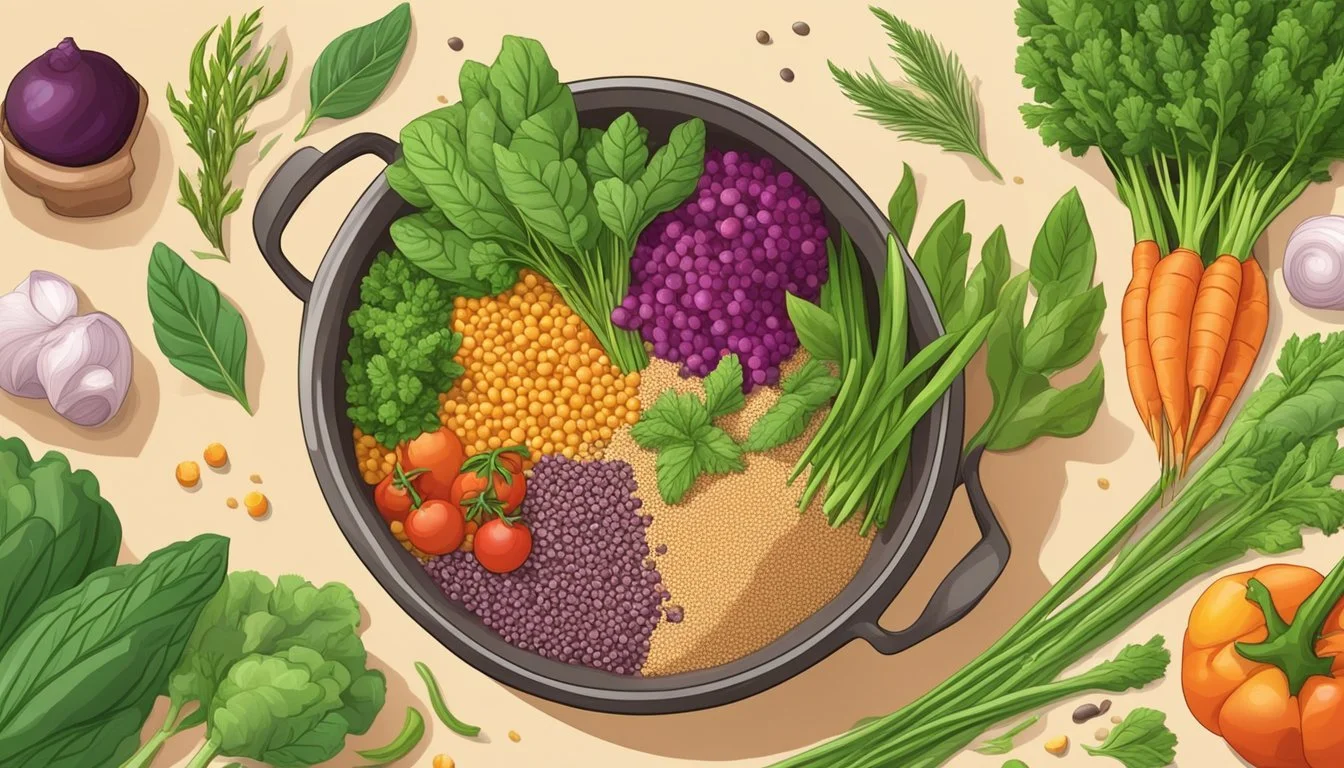Saving Overcooked Amaranth
Tips for Reviving Your Ancient Grain Dish
Amaranth, an ancient grain revered for its nutritional profile, offers a rich source of protein, fiber, iron, calcium, and magnesium. Originating from the pre-Columbian Americas, it has gained popularity in modern kitchens for its versatility and health benefits. Unlike many other grains, amaranth is known for being a complete protein, including all nine essential amino acids that the body cannot produce on its own. This makes it an excellent dietary component, especially for those seeking plant-based protein options.
Preparing amaranth can sometimes be a challenge, as this tiny grain can easily become overcooked, resulting in a texture that is less than desirable for many dishes. When overcooked, amaranth can turn into a sticky mass that may not appeal to everyone's palate. However, with the right techniques and a bit of culinary ingenuity, it's not only possible but relatively simple to save overcooked amaranth and transform it into a pleasing meal that still boasts its powerful protein-packed punch.
Incorporating overcooked amaranth into various dishes can ensure that none of this valuable grain goes to waste, while still providing a delicious and nutrient-dense component to meals. Understanding the properties of amaranth and the best practices for cooking it can help prevent mishaps, but knowing how to revive amaranth when it's past the ideal cooking point can be an equally important skill for health-conscious cooks and enthusiasts of ancient grains.
Amaranth: A Nutritional Powerhouse
Amaranth seeds bring a remarkable nutritional profile to the table, including high protein content and a range of vitamins and minerals. Its gluten-free nature also makes it a substantial health food store staple, particularly for those with dietary restrictions.
Profile of Amaranth Seeds
Amaranth seeds are a high-protein choice offering a complete amino acid profile, which is rare in plant-based proteins. A single cup of cooked amaranth contains approximately 9 grams of protein and 5 grams of dietary fiber, making it highly nutritious. The grain's status as a complete protein means it contains all nine essential amino acids necessary for the human body.
Calories: 251
Protein: 9.3 grams
Carbohydrates: 46 grams
Fat: 5.2 grams
Fiber: 5 grams
Amaranth vs. Other Grains
Compared to other grains, amaranth stands out for its protein density. For instance, quinoa, another popular ancient grain, is often celebrated for its protein content, yet amaranth typically provides a higher amount. Both are gluten-free options and complete proteins, which makes them excellent choices for diverse diets. Unlike many grains that lack lysine, an essential amino acid, amaranth is well-endowed in this regard.
Health Benefits of Amaranth
Fiber-rich and packed with antioxidants, amaranth contributes to improved digestion and may aid in reducing cholesterol levels. This ancient grain, once a staple in Aztec cuisine, contains abundant minerals like manganese and magnesium that support bone health and metabolic functions.
Rich in Antioxidants: Helps protect against oxidative stress.
High Fiber Content: Benefits digestion and cardiovascular health.
Plant Sterols: May have cholesterol-lowering properties.
Vitamins and Minerals: Amaranth is a good source of iron, manganese, magnesium, phosphorus, and iron, which are vital for a range of body functions.
Consumed as a health food, amaranth can be a versatile component of any diet. Whether incorporated into savory dishes or sweet treats, its nutritional benefits are manifold.
Culinary Uses of Amaranth
Amaranth, a highly nutritious ancient grain, presents a diversity of cooking techniques and applications, yielding both savory and sweet dishes. Its versatility can elevate a simple meal with its protein-packed seeds and appealing texture.
Cooking Techniques
Amaranth seeds can be cooked using various techniques. Boiling is a common method, where one part amaranth is typically cooked in three parts water for about 20 minutes until tender. For a different texture, amaranth can be roasted in a skillet to create a nutty flavor. Additionally, amaranth can be popped like popcorn, offering a crispy element to dishes, or used to thicken soups and stews.
Amaranth for Breakfast
Transform morning meals with amaranth. It serves well as a warm porridge, cooked in milk or water, and sweetened with maple syrup or fruits. For a more robust breakfast, it complements oats in a granola blend or can be added to pancakes and muffins for extra nutrition.
Savory Amaranth Recipes
In savory dishes, amaranth seeds lend their texture to stews and chili, absorbing flavors while contributing a pleasant bite. Cooked amaranth can be used as a stuffing, prepared with vegetables, nuts, or meat. It also complements vegan dishes, such as chia pudding, when mixed with suitable seasonings.
Sweet Treats and Snacks
Amaranth's mild, nutty taste pairs well with sweet flavors. Popped amaranth can be combined with nuts and honey for homemade bars. It's also a nutritious replacement for cereal when mixed with almond butter and cinnamon, offering a satisfying crunch while maintaining a wholesome profile.
Preventing and Salvaging Overcooked Amaranth
Overcooked amaranth can compromise texture and taste, but it can often be salvaged or repurposed in various dishes. These tips will help maintain the integrity of this protein-packed grain.
Identifying Overcooked Amaranth
Overcooked amaranth is characterized by a loss of the grain's distinct, slightly crunchy texture, turning into a sticky and mushy consistency. The amaranth may also form a thicker paste-like substance as opposed to a fluffy pile of grains. Timely observation of the texture is crucial for salvaging it before it becomes inedible.
Repurposing Overcooked Amaranth
When amaranth has passed the desired texture, it's not the end of its usability. It can be repurposed in ways that complement its thick, porridge-like consistency:
Thicken Soups and Stews: Stir overcooked amaranth into soups or stews as a thickening agent.
Make Patties or Fritters: Combine it with binding ingredients, form into patties, and pan-fry for amaranth fritters.
Prepare Amaranth Pudding: Sweeten with a bit of honey or maple syrup, add milk or a milk alternative, and chill to make a pudding.
Cooking Tips to Avoid Overcooking
Preventing overcooking amaranth is simple with these straightforward tips:
Water Ratio: Use a water-to-amaranth ratio of about 2.5 to 1 for optimal consistency.
Cooking Time: A standard cooking time is approximately 20 minutes. Check the texture from 15 minutes onward to ensure it doesn't overcook.
Lower Heat: Once boiling, reduce the heat to simmer and cover the pot. This allows for even cooking without excessive water loss.
Regular Stirring: Stir occasionally to prevent sticking to the bottom and promote even cooking throughout.
Cooling: To stop the cooking process and prevent further softening, spread the cooked amaranth on a baking sheet to cool quickly.
Incorporating Amaranth into a Healthy Diet
Amaranth's rich protein content and compatibility with diverse diets make it an excellent choice for enhancing the nutritional value of meals. Whether one adheres to a plant-based diet or deals with celiac disease, amaranth can fit seamlessly into various meal plans due to its versatility.
Amaranth for Different Diets
For individuals with celiac disease or gluten sensitivity, amaranth is a gluten-free alternative that can be safely incorporated into the diet without risking nutrient absorption issues. As a complete protein, amaranth provides all nine essential amino acids, making it an ideal staple for vegans and vegetarians who often seek out plant-based foods that can supply sufficient protein. Additionally, amaranth's high fiber and iron content contribute further to its dietary value.
Gluten-free alternative: For those with gluten sensitivities or celiac disease.
Plant-based protein: Suitable for vegans and vegetarians.
Rich in nutrients: High in fiber and iron.
Introducing Amaranth to Your Meals
Introducing amaranth into the diet can be as simple as incorporating it into soups, stews, salads, or as a side dish to main courses. One can use it as a base in grain bowls, pairing it with abundant vegetables, legumes, and proteins such as chicken or shrimp for added nutrition. Amaranth originates from the ancient Maya cuisine and has been a staple for centuries. Today, it can be found integrated in modern culinary practices, praised for its nutrient density and hearty texture.
Pilaf or risotto: Substitute rice with amaranth for a nutritious twist.
Breakfast cereal: Cooked amaranth can be served with fruits and nuts.
Soups and stews: Add amaranth to thicken and boost the protein content.
Portion Control and Balance
While amaranth is beneficial for its nutrient-rich profile, portion control is key to maintaining a balanced diet. Typically, a serving size of cooked amaranth is about half a cup. This portion size ensures that one reaps the benefits of its protein, fiber, and minerals without overconsuming. Amaranth should complement a diet that includes a variety of whole grains and plant-based foods to ensure a full spectrum of nutrients is achieved.
Serving size: 1/2 cup cooked.
Balanced diet: Complement with other whole grains and varied diet.
In summary, amaranth is a versatile and nutritious grain that can support various dietary needs and preferences. Its role in a balanced, healthy diet is significant for those seeking gluten-free options or plant-based sources of protein and other essential nutrients.
A Historical Perspective on Amaranth
Amaranth, an ancient grain revered for its nutritional properties, has been a staple in diets for centuries. With a rich history dating back to ancient civilizations and a modern resurgence in health-conscious societies, its story spans from traditional uses to current cultivation practices.
Amaranth in Ancient Cultures
Amaranth's origins trace back to Mesoamerica, where it was a significant food source for the Aztecs. Cultivated for its seeds and leaves, this resilient crop was consumed in a variety of ways, including as a cereal grain and incorporated into ritualistic practices. For the Incas, amaranth held similar importance within their diverse agricultural systems. What made amaranth distinctive was its classification as a pseudocereal—a non-grassy plant yielding seeds that are used similarly to cereal grains.
Historical Significance
Staple food for Aztecs and Incas
Used for ceremonial purposes by Aztecs
Classified as a pseudocereal
It was not merely consumed; the crop also played a pivotal role in religious ceremonies. The Aztecs would fashion amaranth grains into figures for worship, signifying its integral part in both their diet and culture. However, post-European contact, amaranth's cultivation was significantly suppressed due to its association with these non-Christian rituals.
Modern Cultivation and Use
Moving beyond its storied history, amaranth's recent revival can be attributed to renewed interest in its health benefits and the adaptability of its cultivation. Recognized by the USDA and health researchers alike, amaranth's composition of complete protein and essential amino acids has made it increasingly popular. Modern cultivation spans various regions, including China, India, and parts of Africa, alongside a growing number in the United States recognizing amaranth's potential in addressing food security and nutritional deficiencies.
Contemporary Aspects
Endorsed by USDA for nutritional value
Grown globally
Contributing to food security
In the present day, amaranth is appreciated not only for its resilience as a crop but also for its versatility in the kitchen. This has led to a resurgence in its cultivation, with a focus on organic farming practices and sustainable agriculture, echoing the grain's historical importance while tackling current global challenges.
Nutritional Science of Amaranth
Amaranth is not only a gluten-free grain that is sustainable to grow, but it also stands out for its remarkable nutritional value, including a rich profile of both macronutrients and micronutrients, and positive impacts on bodily functions backed by scientific research.
Macro and Micro Nutrient Profile
Amaranth grain is notably high in protein, boasting a complete set of essential amino acids, which are crucial for human health. In particular, amaranth protein is rich in lysine, an amino acid that is often limited in grains. The grain's amino acid profile is comparable to that of milk, making it an exceptional plant-based protein source.
Nutrient-wise, amaranth is an excellent source of vital minerals including manganese, phosphorus, copper, and zinc, fulfilling key dietary needs. The concentrations include roughly:
Manganese: Important for bone development and wound healing.
Phosphorus: Assists in energy storage and transferring within the body.
Copper: Fundamental for maintaining a healthy immune system and creating red blood cells.
Zinc: Crucial for immune function, protein synthesis, and DNA formation.
Amaranth's Role in Body Function
This grain's micronutrients play significant roles in maintaining body health. Manganese is involved in bone formation and blood clotting, while phosphorus is essential in forming bones and teeth. Copper assists in the formation of collagen, energy production, and iron absorption. Zinc supports the immune system, efficient wound healing, and promotes the synthesis of immune-supporting antibodies.
Moreover, the high-quality protein in amaranth is useful for building and repairing tissues and the production of enzymes and neurotransmitters. These compounds are vital for brain function and signaling between different parts of the body.
Scientific Research on Amaranth
The grain's protein includes a peptide called lunasin, which has been studied for its role in reducing inflammation and potentially protecting against cancer. Amaranth also contains an abundant amount of antioxidants, which help combat oxidative stress in the body, and ongoing research suggests that these may contribute to cardiovascular health and general wellness.
Scientific analyses validate the versatility of amaranth in various gluten-free products, while retaining its functional properties such as a high protein content that enhances nutritional quality. The presence of both soluble and insoluble fibers in amaranth has been linked to positive digestive health, blood sugar regulation, and a decrease in cholesterol levels.
Storing and Shelf Life of Amaranth
Ensuring proper storage of amaranth is crucial for maintaining its quality and extending its shelf life. Correct techniques can keep this nutrient-rich grain ready for when one needs to salvage their overcooked dishes.
Proper Storage Techniques
One should store raw amaranth grain in a cool, dry place away from direct sunlight. Airtight containers are ideal for maintaining the grain's freshness and protecting it from moisture and pests. This method significantly reduces the risk of spoilage and helps maintain the grain's nutritional value.
Maximizing Freshness
To further extend the shelf life of amaranth, it can be kept in a refrigerator or freezer in sealed containers or bags designed for long-term food storage. When dried properly before storage, amaranth's shelf life can improve remarkably, lasting several months without a loss in quality.
Recognizing Spoilage
One can identify spoilage in amaranth by a change in color, smell, or the presence of pests. Any signs of moisture, such as clumping or mold, indicate that the amaranth is no longer suitable for consumption. One should regularly inspect the stored grain to ensure it remains in optimal condition for use in a variety of dishes.
Amaranth and Health Special Considerations
As an ancient grain packed with protein and nutrients, amaranth has multiple health benefits. However, certain special considerations around its consumption should be noted. This includes its interactions with medications, potential for food allergies or intolerances, and how it affects specific populations.
Interactions with Medication
The consumption of amaranth should be approached with caution for individuals on specific medications, due to the grain's possible impact on absorption or effectiveness. Amaranth's high fiber content can potentially influence both blood sugar and cholesterol levels, which is pertinent for those on diabetes or lipid-lowering medications. Individuals should consult their healthcare provider to discuss how incorporating amaranth into their diet could interact with their prescriptions.
Food Allergies and Intolerance
Even though amaranth is not a common allergen, instances of intolerance or allergic reactions could occur. Individuals with sensitive gastrointestinal tracts may experience issues due to the high fiber content, which can affect digestive health. Signs of an allergic reaction include itching, swelling, or gastrointestinal distress. Those suspecting a food allergy should seek professional advice.
Special Populations
When considering special populations like young infants, pregnant women, or the elderly, amaranth's nutrient profile is important. A 6-month-old baby, for instance, may not be able to digest the protein and fiber in amaranth, necessitating a tailored approach to its introduction.
Iron needs: Amaranth contains nonheme iron, which is less readily absorbed than heme iron found in animal products. However, the vitamin C in amaranth can enhance nonheme iron absorption, beneficial for individuals requiring increased iron, such as pregnant women and those with anemia, to aid in the formation of red blood cells and the transport of oxygen in the body.
Blood sugar management: Amaranth's complex carbohydrates can help stabilize blood sugar levels, which may be particularly beneficial for those managing diabetes.
Cholesterol management: The fiber in amaranth can also assist in managing cholesterol levels, relevant for those with heart disease or high cholesterol.
Careful incorporation of amaranth into the diet can be advantageous, but should be adapted to individual health needs and circumstances.
FAQs and Troubleshooting Common Amaranth Questions
This section addresses frequently asked questions regarding amaranth, offering practical tips for cooking, nutritional insights, and alternative options for those seeking variety in their dishes.
Cooking and Preparation Queries
Q: How does one salvage overcooked amaranth? A: Overcooked amaranth can often turn into a sticky situation. To remedy this, spread it on a baking sheet and bake at a low temperature to dry out the excess moisture. One can also transform it into a side dish by adding herbs and a touch of olive oil.
Q: Are there any specific tips for cooking amaranth? A: Always use a fine mesh strainer to rinse amaranth before cooking to remove saponins, which can impart a bitter taste. The ideal cooking ratio is 1:3, amaranth to liquid, and it should simmer for about 20-25 minutes until the liquid is absorbed.
Nutritional Information Clarification
Q: What is the protein content in amaranth? A: Amaranth is a protein powerhouse, with one cup of cooked grain containing about 9 grams of protein. It is a complete protein, meaning it contains all nine essential amino acids.
Q: Is amaranth a good source of fiber? A: Yes, amaranth is rich in fiber, contributing to digestive health. A single serving can provide up to 5 grams of dietary fiber.
Substitutions and Alternatives
Q: Can amaranth be used as a gluten-free alternative? A: Amaranth is an excellent gluten-free option that can substitute commonly used grains in recipes, perfect for those with gluten sensitivities or celiac disease.
Q: What are some alternatives to amaranth if it’s unavailable? A: Quinoa, buckwheat, and chia are suitable substitutes for amaranth. They share similar pseudo-cereal properties and can be used interchangeably in most recipes.










